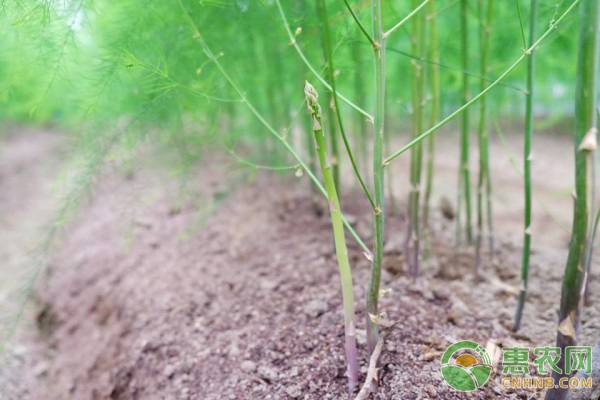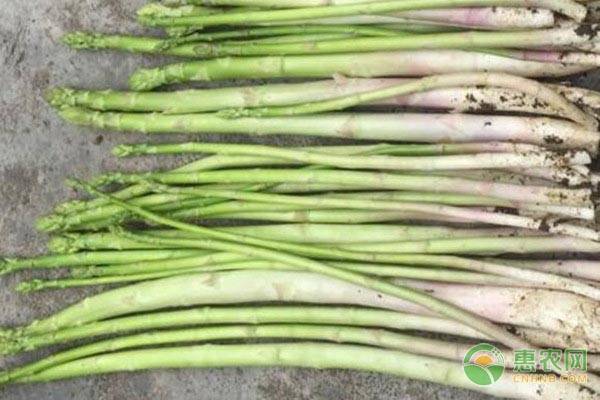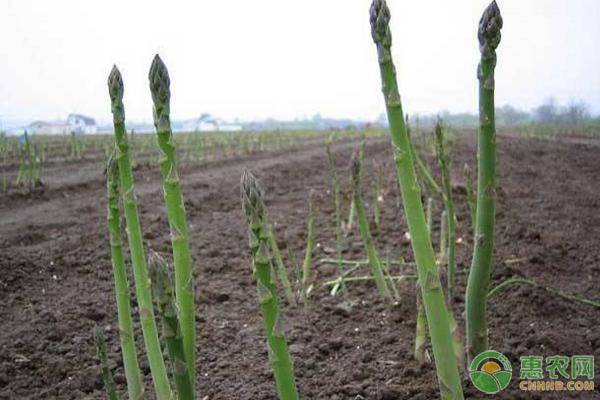Asparagus is one of the world's top ten famous dishes. It also has the reputation of “king of vegetables†in foreign countries. At present, the price on the market is also relatively expensive, so many farmers choose to grow asparagus. Today, Xiaobian will introduce the efficient planting techniques and management points of asparagus.
1. Growth environment
(1) Temperature: Asparagus has a strong adaptability to temperature, and it is both cold and heat resistant. When the spring temperature rises above 5 °C, the asparagus buds begin to sprout; the tender stems begin to elongate above 10 °C; 15-17 °C is most suitable for the formation of asparagus shoots; more than 30 °C plant growth is blocked into summer sleep. In the northern part of the country, the upper part of the winter is withered, and the underground rhizomes and fleshy roots enter the dormant period for wintering, while in the south, the asparagus does not have obvious winter dormancy.
(2) Moisture: The root system of asparagus is developed, it is more drought-tolerant, but it is very intolerant. If there is water in the field, it will easily cause roots. Therefore, the plots where the asparagus is planted must have a high topography, and the rainy season should be timely drained in the field.
(3) Soil: The most suitable asparagus for sand soil growth, the soil needs to meet the conditions of soil looseness, fertilizer and water retention, and good gas permeability. It should be noted that the soil salt content should not be higher than 0.2%, which will affect the development of the plant, make the stems and leaves weak, and gradually die. Asparagus has a strong adaptability to soil pH, and can be cultivated in soil with acidity and alkalinity of 5.5-7.8.

2, selection of seedlings
Common asparagus varieties include Grande, Daboli, Lulushan No. 2, etc. Vegetable farmers can select suitable asparagus seeds according to the local market. Asparagus is broadcast in spring and can also be broadcast in autumn. Spring sowing can be planted in February, planted in April, harvested in the next spring; autumn sowing can be planted in September, planted in November, and harvested in the next fall.
(1) Germination sowing: As the asparagus seeds have a thick outer shell and slow water absorption, they need to be soaked and then germinated. Soak the seeds with 50% carbendazim 300-500 times for 24 hours, then soak them in 25-30 °C warm water for 2-3 days, and replace the new water 2-3 times a day. The seed after soaking is wrapped with clean gauze, and it is germinated under the condition of 25-30 °C. During the germination, it is poured 1-2 times with warm water of about 25 °C every day. When 80% of the seeds are white, the seedling can be sown.
(2) Nursery: Generally, nutrition is used to raise seedlings. A nutrient crucible with a diameter of 10 cm can be used. The vegetable soil and organic fertilizer were taken in a ratio of 2:1, then mashed, sieved, and mixed to form a nutrient soil, and covered with a film for 7 days. At the time of sowing, the nutrient soil is firstly planted, and the soil is poured once, then a small hole is placed in the center of the soil, and the seeds of the germination are sprinkled into the hole, and finally the hole is filled with the nutrient soil.
During the nursery period, the nutrient temperature during the day should be kept at around 25 °C, the night temperature should be maintained at 15-20 °C, and the urea water and fertilizer should be chased once on the 20th and 40th day after the seedling, but the water in the seedbed should not be avoided. When the seedling age is 60-70 days and the number of stems is 3-5, the colonization can be started.
3. Transplanting and planting
(1) Site preparation: Asparagus is drought-tolerant and resistant to cockroaches, and it can be harvested for about 10 years. Therefore, the terrain of the land is high and easy to drain, and the soil has good fertility and permeability. Generally, 1-2 tons of organic fertilizer and 50 kilograms of compound fertilizer are applied per mu, and the fertilizer is turned into the soil with deep tillage, and the land is leveled after tillage. Then, according to the north-south trend, the rowing distance is 1.5 meters to excavate the planting ditch, and the ditch is 30 cm deep. At the time of transplanting, apply 45% of ternary compound fertilizer and 30 kg of cake fertilizer per acre in the planting ditch, and then fill the soil to cover, and keep the planting ditch 10 cm deep.
(2) Colonization: It is advisable to plant an asparagus seedling every 25-30 cm, usually 1500-2000 points per acre. We suggest that one large seedling transplanted with soil at each hole, and two plants with weak seedlings per hole, and the strong and weak seedlings are planted. Cover the soil with a small pot, then gently compact, and then plant an appropriate amount of water to increase the survival rate of the seedlings.

4. Field management
(1) Weeding intercropping.
In the growing season, weeds are easy to grow in the field. It is necessary to weed and weed in time. After each weeding, properly soil 1-2 cm and gradually increase the height of the soil to about 10 cm. 60-70 grams of herbicide suitable for asparagus, such as diuron, aniline, etc., can be used per acre, and 40-50 kg of water is sprayed toward the weeds.
At the same time, because the plant is relatively short in the first year, it can be used as a short crop, such as soybean, onion, garlic, etc., but it is not suitable to plant crops with high water absorption and strong fertility, such as radish.
(2) Chasing water and fertilizer.
1 Slow seedling fertilizer: After 7-10 days after the asparagus is planted, the dung manure water is poured once to reduce the seedlings.
2 Promote long-term fertilizer: In the early stage of planting, it is necessary to apply fertilizer frequently. Generally, it should be applied once after each weeding of the loose soil and before the growth of the new stem. It is suitable to use the decomposed mature manure water, or apply 5 kg of compound fertilizer per acre. As the seedlings grow, it is necessary to apply more fertilizers such as plant ash, coke ash and other potassium-containing fertilizers, and gradually increase the amount of fertilizer used to promote plant growth and root plate expansion.
3 autumn fat: after the fall, it is necessary to apply 1 autumn fertilizer, generally apply 250-500 kilograms of organic biological fertilizer, or 10-15 kilograms of compound fertilizer, and should end fertilization in late October.
(3) Prevention and control of pests and diseases.
1 stem blight. The main manifestations are: the edge of the lesion is reddish-brown, the middle of the depression is slightly grayish brown, and the top is densely pointed with black dots. Control method: Tianqing uses 50% carbendazim 300-400 times solution, or 75% chlorothalonil 400-500 times solution every 7-10 days to spray more than 80 cm of asparagus main stem on the ground, even spray 2-3 Times.
2 root rots. The main manifestations are: purple hyphae on the root surface, the point of invasion of the pathogen is spotted, and the root is gradually surrounded by hyphae. Control method: 45% dasen ammonium 1000 times solution, or 50% sulfur suspension 400 times solution, 80% mancozeb 500 times solution can be sprayed to the root of the disease.
3 pests. Insect pests mainly include underground pests such as Spodoptera litura, Spodoptera exigua, and earthworms. The noctuids can be controlled by 1000 times liquid such as chlorpyrifos. Underground pest larvae can be mixed with wheat bran or bean cake with 90% trichlorfon 30 times solution, sprinkled in the field to make poison bait poisoning, or spray 80% dichlorvos emulsion 800 times solution during fertilization. In the adult stage, insecticidal lamps can be hung to trap adults.
(4) Safe wintering.
1 Qingyuan. Thoroughly clean up the asparagus fields to remove the withered asparagus stems and leaves, which is conducive to the prevention of disease. Remove the asparagus from the shoots of the shoots and then clear the plot together with the litter.
2 plot disinfection. In order to prevent pests and diseases remaining in the plot, it needs to be disinfected. It can be sprayed with 50% carbendazim 300-500 times solution and agricultural anti-120-200 times solution for disinfection and rooting.

5, harvesting considerations
When the asparagus shoots grow to about 20 cm and you can see that the tip is loose, you can harvest it. However, it should be noted that the harvest of young bamboo shoots in adult plants can last for about 40 days, but the harvest period in the second year of planting should be shortened appropriately.
At the time of harvesting, each plant was selected to be evenly distributed, with no pests and diseases, and about 3 young stems, and all the other young shoots were harvested. Stop harvesting around mid-August, carry out the clearing of the tree, and leave the autumn female stem again. After the autumn stem is left, the young shoots can be harvested according to the growth. The number of stems should be adjusted according to the growth period and growth of asparagus, and the fertilizer should be supplemented during harvesting.
The above is the planting technology and scientific management points of asparagus. Asparagus is a kind of crop with high economic benefit. When planted in the same year, it can be harvested in the second year, and the plant can be harvested continuously for up to 8-10 years, and its market demand is also More, it is worth planting.
For the wonderful pictures and popular comments on growing asparagus, you may be interested in the following recommended content, welcome to read.
Dental Storage Cabinet/Trolley
dental cabinet,dental cabinet with sink,mobile dental cabinet,dental cabinet furniture clinic
Foshan Ja Suo Medical Device Co., LTD , https://www.jasuodental.com